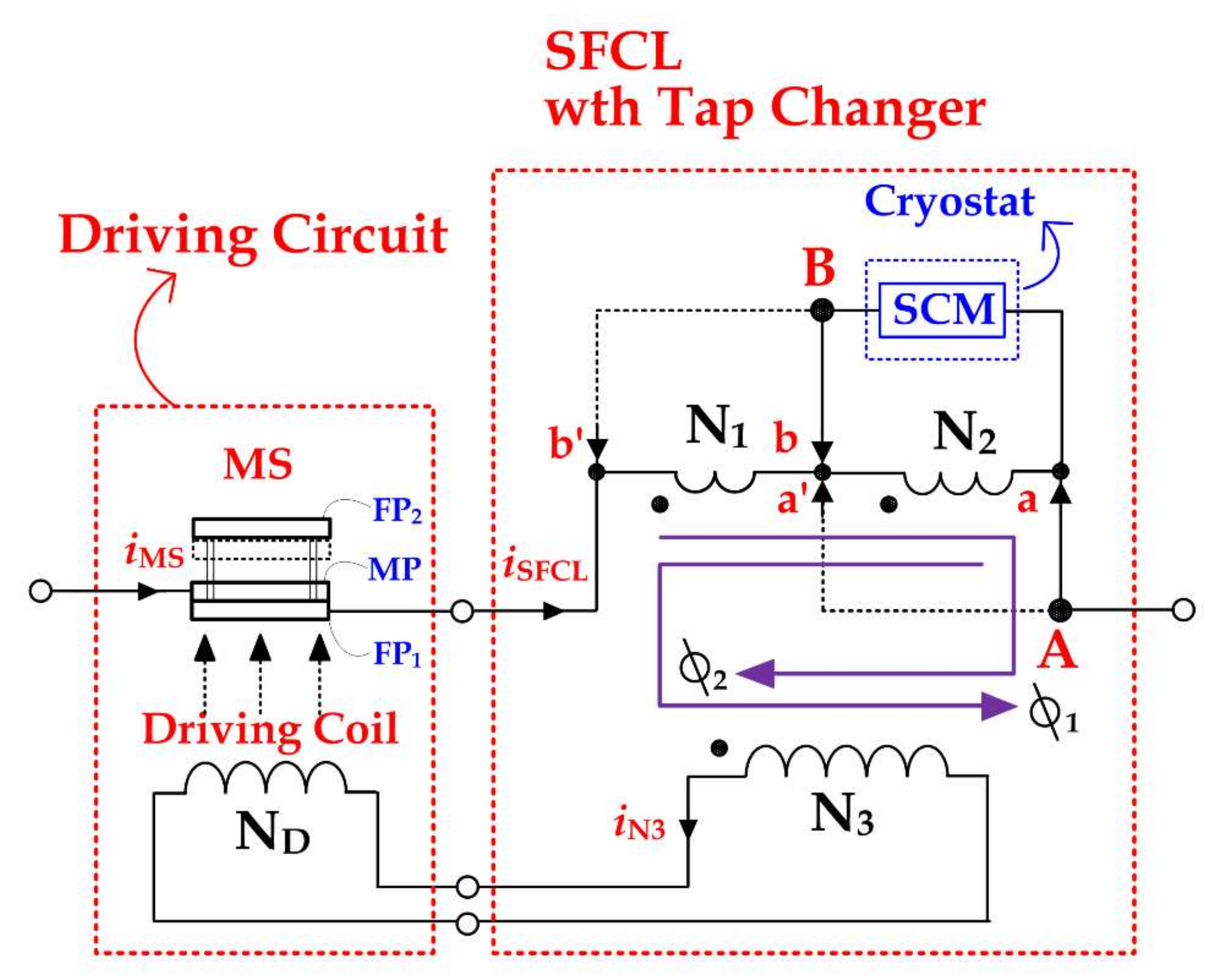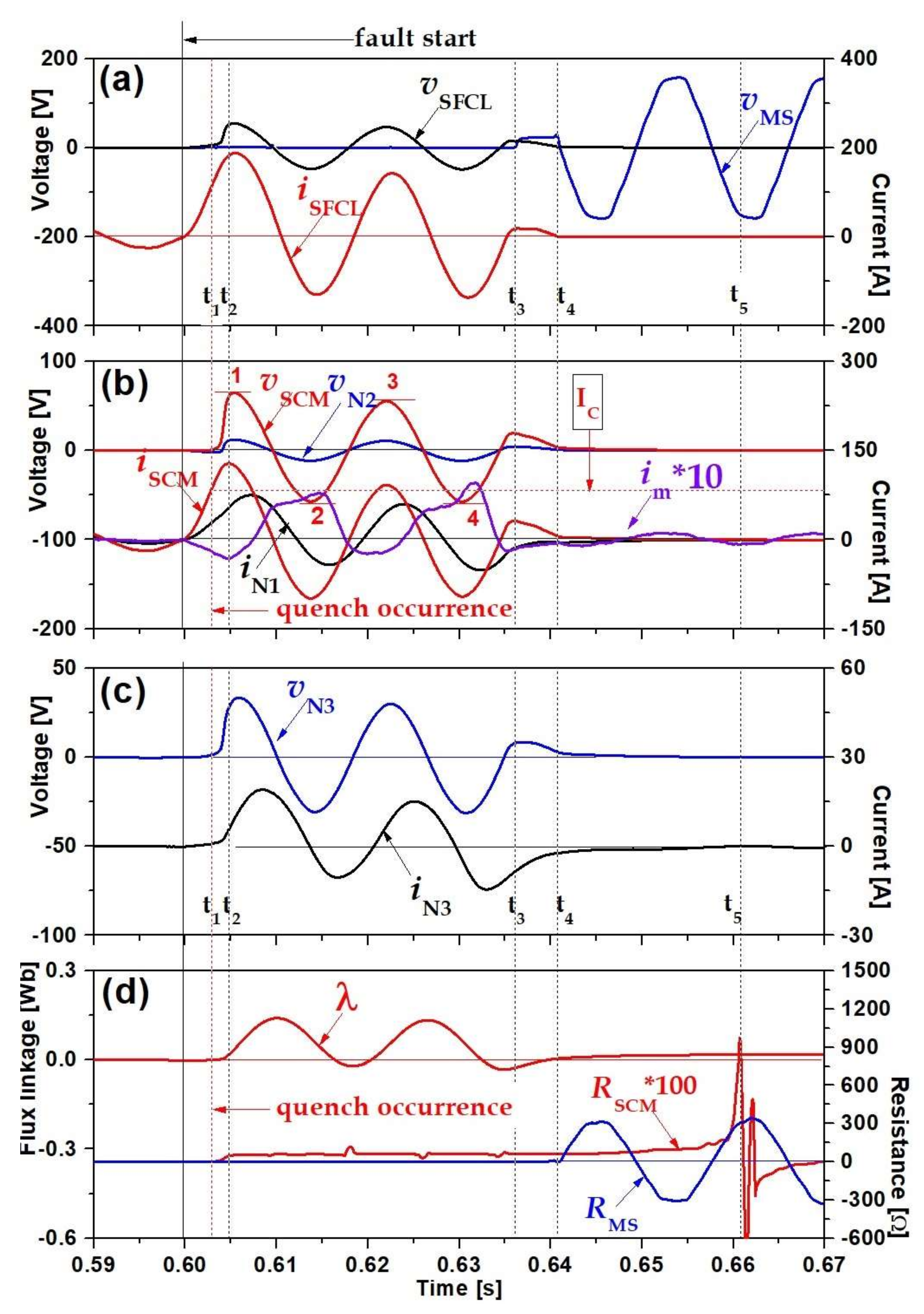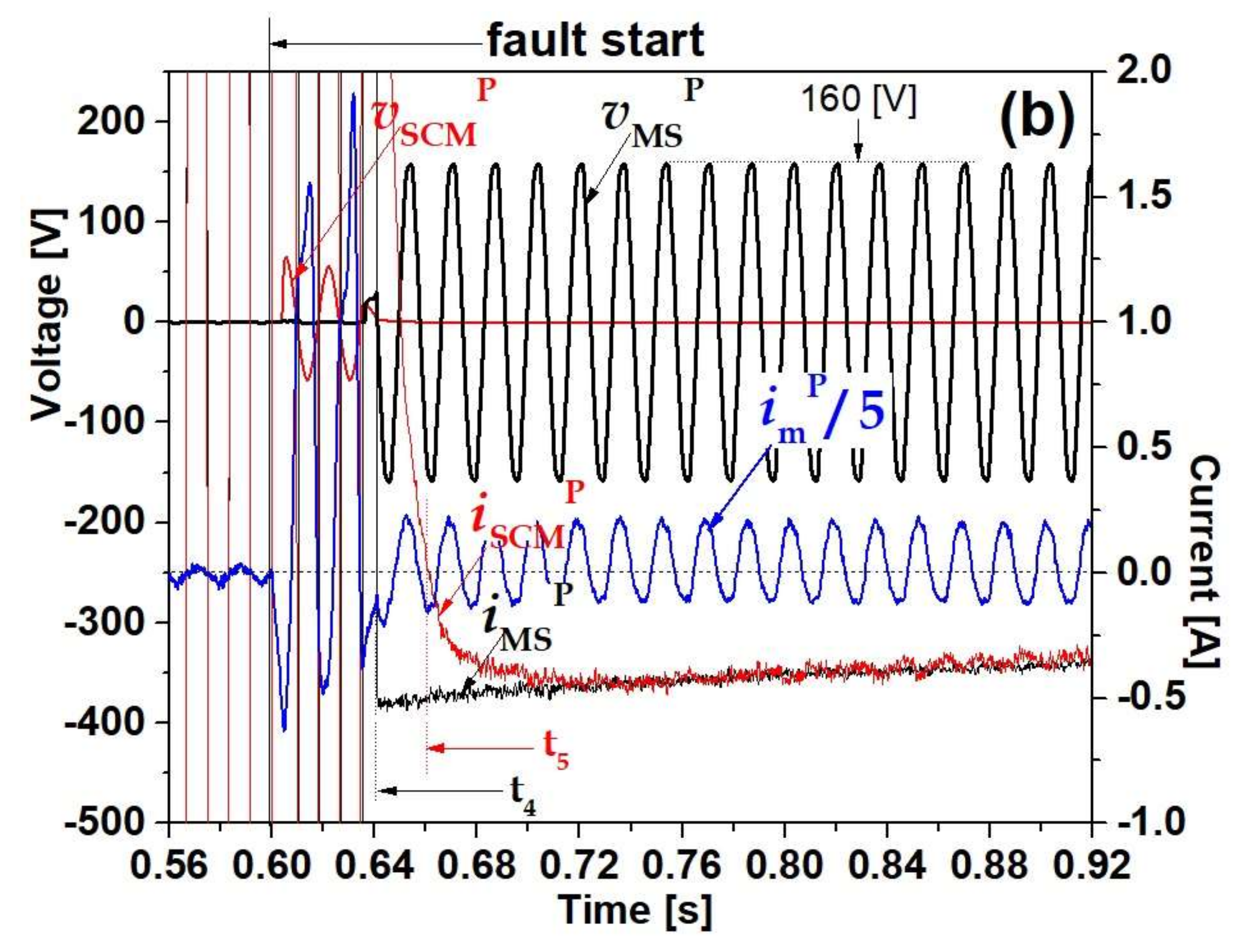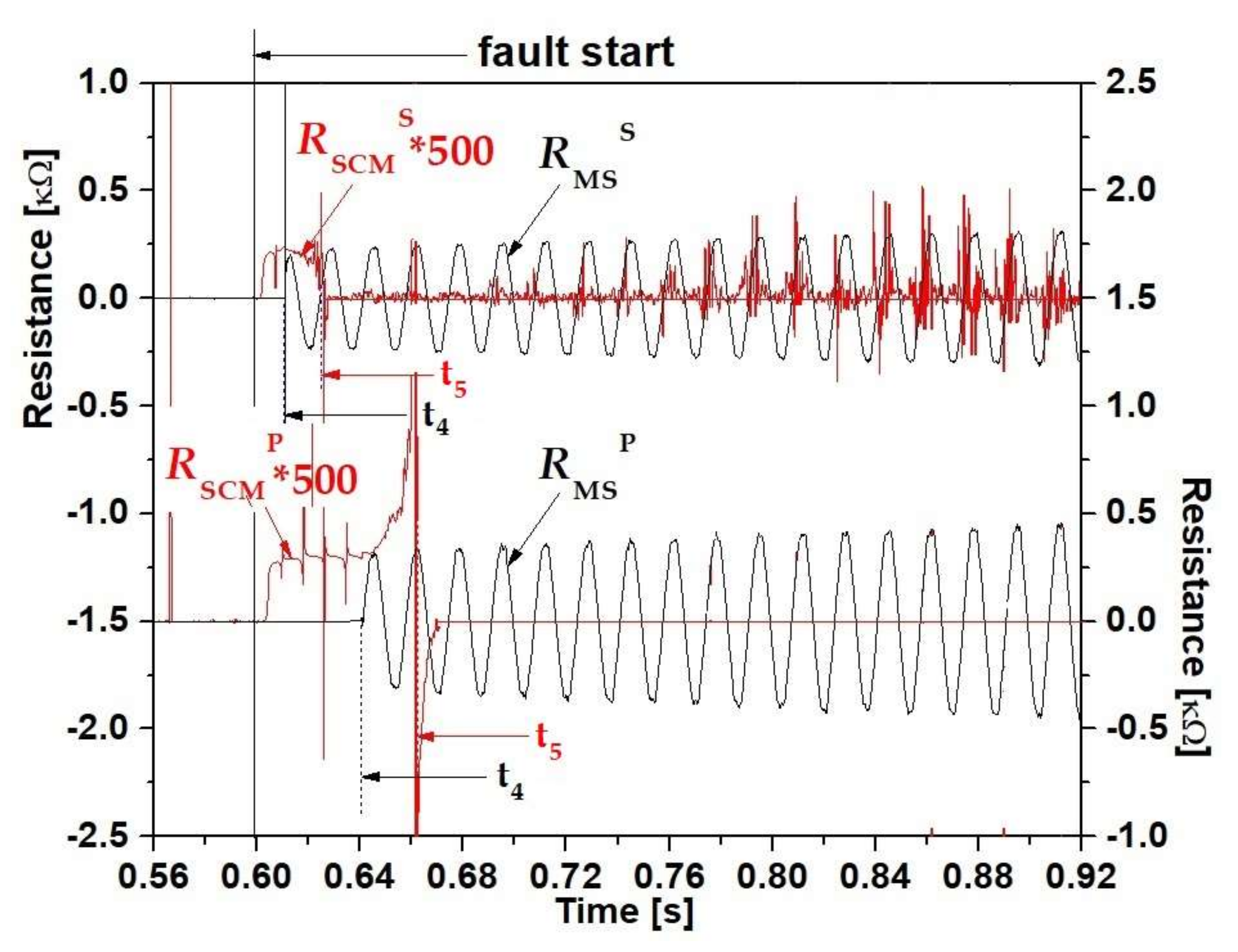Fault Current Limiting and Breaking Characteristics of SFCLB Using Flux Coupling with Tap Changer
Abstract
:1. Introduction
2. Structure and Operational Principle
2.1. Structure
2.2. Operational Principle
3. Experimental Setup
4. Results and Discussion
5. Conclusions
Author Contributions
Funding
Conflicts of Interest
Appendix A
| Component | Parameter | Value | Unit |
|---|---|---|---|
| Driving Circuit | |||
| MS (FP1, FP2, MP) | Thickness | 3 | mm |
| Diameter of Each Plate | 100 | mm | |
| Material | Aluminum | ||
| Distance between Two Fixed Plates | mm | ||
| Bobbin | Cylindrical Form | 100 | mm |
| Height | |||
| Outer Diameter | 120 | mm | |
| Inter Diameter | |||
| Turn Number | 120 | Turns | |
| Driving Coil (ND) | Turn Number | 300 | Turns |
| Coupled Coils with Tap Changer | |||
| Iron Core | Vertical Length of Outer Edge | 235 | mm |
| Height of Outer Edge | 250 | mm | |
| Vertical Length of Inner Edge | 137 | mm | |
| Height of Inner Edge | 155 | mm | |
| Thickness | 132 | mm | |
| Permeability Ratio(μr) | 8000–10,000 | H/m | |
| Coupled Coils | Turn Number of Primary Coil (N1) | 45 | Turns |
| Turn Number of Secondary Coil (N2) | 15 | Turns | |
| Turn Number of Tertiary Coil (N3) | 120 | Turns | |
| Superconducting Module (SCM) | |||
| Material | YBCO | ||
| Fabrication form | Film Type | ||
| Total Line Length | 420 | mm | |
| Line width | 2 | mm | |
| Thickness of Whole Film | 0.3 | μm | |
| Thickness of Gold Layer | 0.2 | μm | |
| Critical Temperature (TC) | 87 | K | |
| Critical Current (IC) | 27 | A | |
| Three HTSC Modules (SC1, SC2, SC3) Connected in Parallel | |||
| Total Critical Current | 81 | A | |
| Operational Sequential Time | t1 (s) | t2 (s) | t3 (s) | t4 (s) | t5 (s) |
|---|---|---|---|---|---|
| Description | Quench starting time | Approaching time to first peak value | Starting time of breaking operation | Opening time of CB | Approaching time into zero value of SCM current |
| Series Connection | 0.60090 | 0.60196 | 0.60557 | 0.61088 | 0.62452 |
| Parallel Connection | 0.60290 | 0.60480 | 0.63610 | 0.64072 | 0.66076 |
References
- Ye, L.; Lin, L.Z.; Juengst, K.P. Application studies of superconducting fault current limiters in electric power systems. IEEE Trans. Appl. Supercond. 2002, 12, 900–903. [Google Scholar]
- Jiang, Y.; Dongyuan, S.; Xianzhong, D.; Yuejin, T.; Shijie, C. Comparison of superconducting fault current limiter in power system. In Proceedings of the 2001 Power Engineering Society Summer Meeting, Conference Proceedings (Cat. No.01CH37262). Vancouver, BC, Canada, 15–19 July 2001; pp. 43–47. [Google Scholar]
- Lim, S.H.; Choi, H.S.; Chung, D.C.; Jeong, Y.H.; Han, Y.H.; Sung, T.H.; Han, B.S. Fault Current Limiting Characteristics of Resistive Type SFCL Using a Transformer. IEEE Trans. Appl. Supercond. 2005, 15, 2055–2058. [Google Scholar] [CrossRef]
- Alam, M.S.; Abido, M.A.Y.; El-Amin, I. Fault Current Limiters in Power Systems: A Comprehensive Review. Energies 2018, 11, 1025. [Google Scholar]
- Kovalsky, L.; Yuan, X.; Tekletsadik Keri, K.; Bock, A.J.; Breuer, F. Applications of superconducting fault current limiters in electric power transmission systems. IEEE Trans. Appl. Supercond. 2005, 15, 2130–2133. [Google Scholar]
- Chen, Y.; Liu, X.; Sheng, J.; Cai, L.; Jin, Z.; Gu, J.; An, Z.; Yang, X.; Hong, Z. Design and Application of a Superconducting Fault Current Limiter in DC Systems. IEEE Trans. Appl. Supercond. 2014, 24, 5601305. [Google Scholar]
- Naoki, H.; Yuya, M.; Hiroki, K. Fault Current Limitation Coordination in Electric Power Grid with Superconducting Fault Current Limiters. IEEE Trans. Appl. Supercond. 2018, 28, 5602304. [Google Scholar]
- Martini, L.; Bocchi, M.; Angeli, G.; Ascade, M.; Rossi, V.; Valzasina, A.; Ravetta, C.; Fratti, S.; Martino, E. Live Grid Field-Testing Final Results of the First Italian Superconducting Fault Current Limiter and Severe 3-Phase Fault Experience. IEEE Trans. Appl. Supercond. 2015, 25, 5600405. [Google Scholar] [CrossRef]
- Song, M.; Tang, Y.; Zhou, Y.; Ren, L.; Chen, L.; Cheng, S. Electromagnetic Characteristics Analysis of Air-Core Transformer Used in Voltage Compensation Type Active SFCL. IEEE Trans. Appl. Supercond. 2010, 20, 1194–1198. [Google Scholar] [CrossRef]
- Kim, H.R.; Yang, S.E.; Yu, S.D.; Kim, H.; Park, B.J.; Han, Y.H.; Park, K.; Yu, J. Development and Grid Operation of Superconducting Fault Current Limiters in KEPCO. IEEE Trans. Appl. Supercond. 2014, 24, 5602504. [Google Scholar]
- Hyun, O.B.; Yim, S.W.; Yu, S.D.; Yang, S.E.; Kim, W.S.; Kim, H.R.; Lee, G.H.; Sim, J.; Park, K.B. Long-Term Operation and Fault Tests of a 22.9 kV Hybrid SFCL in the KEPCO Test Grid. IEEE Trans. Appl. Supercond. 2011, 21, 2131–2134. [Google Scholar] [CrossRef]
- Lee, B.W.; Park, K.B.; Sim, J.W.; Oh, I.S.; Lee, H.G.; Kim, H.R.; Hyun, O.B. Design and Experiments of Novel Hybrid Type Superconducting Fault Current Limiters. IEEE Trans. Appl. Supercond. 2008, 18, 624–627. [Google Scholar] [CrossRef]
- Park, D.K.; Chang, K.S.; Yang, S.E.; Kim, Y.J.; Ahn, M.C.; Yoon, Y.S.; Kim, H.M.; Park, J.W.; Ko, T.K. Analytical and Experimental Studies on the Hybrid Fault Current Limiter Employing Asymmetric Non-Inductive Coil and Fast Switch. IEEE Trans. Appl. Supercond. 2009, 19, 1896–1899. [Google Scholar] [CrossRef]
- He, Z.; Wang, S. Design of the Electromagnetic Repulsion Mechanism and the Low-Inductive Coil Used in the Resistive-Type Superconducting Fault Current Limiter. IEEE Trans. Appl. Supercond. 2014, 24, 1–4. [Google Scholar] [CrossRef]
- Endo, M.; Hor, T.; Koyama, T.; Kaiho, K.; Yamaguchi, I.; Arai, K.; Mizoguchi, H.; Yanabu, S. Development of a superconducting fault current limiter using various high-speed circuit breakers. IET Electr. Power Appl. 2009, 3, 363–370. [Google Scholar] [CrossRef]
- Yang, K.; Yang, Y.; Junaid, M.; Liu, S.; Liu, Z.; Geng, Y.; Wang, J. Direct-Current Vacuum Circuit Breaker With Superconducting Fault-Current Limiter. IEEE Trans. Appl. Supercond. 2018, 28, 5600108. [Google Scholar] [CrossRef]
- Lim, S.H.; Cho, Y.S.; Choi, H.S.; Han, B.S. Improvement of Current Limiting Capability of HTSC Elements in Hybrid Type SFCL. IEEE Trans. Appl. Supercond 2007, 17, 1807–1810. [Google Scholar] [CrossRef]
- Lim, S.H.; Ko, S.C.; Han, T.H. Analysis on current limiting characteristics of a transformer type SFCL with two triggering current levels. Phys. C 2013, 484, 253–257. [Google Scholar] [CrossRef]
- Chen, L.; Tang, Y.; Li, Z.; Ren, L.; Shi, J.; Cheng, S. Current Limiting Characteristics of a Novel Flux-Coupling Type Superconducting Fault Current Limiter. IEEE Trans. Appl. Supercond. 2010, 20, 1143–1146. [Google Scholar] [CrossRef]
- Lim, S.T.; Ko, S.C.; Lim, S.H. Analysis on Current Limiting Characteristics of Transformer Type SFCL with Additionally Coupled Circuit. J. Elect. Eng. Technol. 2018, 13, 533–539. [Google Scholar]
- Lim, S.H.; You, I.K.; Kim, J.C. Study on Peak Current Limiting Characteristics of a Flux-Lock Type SFCL Using Its Third Winding. IEEE Trans. Appl. Supercond. 2011, 21, 1275–1279. [Google Scholar] [CrossRef]
- Lim, S.T.; Lim, S.H.; Han, T.H. Analysis on Operation Characteristics and Power Burdens of the Double Quench Trigger Type SFCLs. Prog. Supercond. Cryog. 2017, 19, 33–37. [Google Scholar]
- Lee, H.J.; Kim, J.S.; Lim, S.H.; Kim, J.C. Analysis on Operational Characteristics of Double Quench Flux Lock Type Superconducting Fault Current Limiter. IEEE Trans. Appl. Supercond. 2020, 30, 5600505. [Google Scholar] [CrossRef]
- Lim, S.H. Study on Current Limiting Characteristics of SFCL with Two Trigger Current Levels. Physica C 2010, 445, 1631–1635. [Google Scholar] [CrossRef]
- Kim, J.S.; Kim, J.C.; Lim, S.H. Study on Protection Coordination of a Flux-Lock-Type Superconducting Fault Current Limiter Using Switches. IEEE Trans. Appl. Supercond. 2016, 26, 5602104. [Google Scholar] [CrossRef]
- Lim, S.H.; Ahn, H.J.; Park, C.K. Study on Fault Current Limiting Characteristics of an SFCL Using Magnetic Coupling of Two Coils with Mechanical Switch Driven by Electromagnetic Repulsion Force. IEEE Trans. Appl. Supercond. 2014, 24, 5600704. [Google Scholar]
- Park, M.K.; Choi, S.J.; Lim, S.H. Current Limiting and Interrupting Operations of Flux-Lock Type SFCLI Using Mechanical Switch. IEEE Trans. Appl. Supercond. 2020, 30, 5601805. [Google Scholar] [CrossRef]
- Kim, J.S.; Lim, S.H.; Kim, J.C. Study on Application of Superconducting Fault Current Limiter Considering Risk of Circuit Breaker Short-Circuit Capacity in a Loop Network System. J. Elect. Eng. Technol. 2014, 9, 1789–1794. [Google Scholar] [CrossRef] [Green Version]
- Hyun, O.B.; Park, K.B.; Sim, J.W.; Kim, H.R.; Yim, S.W.; Oh, I.S. Introduction of a Hybrid SFCL in KEPCO Grid and Local Points at Issue. IEEE Trans. Appl. Supercond. 2009, 19, 1946–1949. [Google Scholar] [CrossRef]
- Stemmle, M.; Neumann, C.; Merschel, F.; Schwing, U.; Weck, K.H.; Noe, M.; Breuer, F.; Elschner, S. Analysis of Unsymmetrical Faults in High Voltage Power Systems With Superconducting Fault Current Limiters. IEEE Trans. Appl. Supercond. 2007, 17, 2347–2350. [Google Scholar] [CrossRef]
- Lim, S.H.; Lim, S.T. Current Limiting and Recovery Characteristics of a Trigger-Type SFCL Using Double Quench. IEEE Trans. Appl. Supercond. 2018, 28, 5601305. [Google Scholar] [CrossRef]
- Tokoyoda, S.; Inagaki, T.; Page, F.; Sato, M.; Kamei, K.; Miyashita, M.; Ito, H. Interruption characteristics of vacuum circuit breaker and the application to DCCB. In Proceedings of the 13th IET International Conference on AC and DC Power Transmission (ACDC 2017), Manchester, UK, 14–16 February 2017. [Google Scholar]
- Walterscheid, D. Medium-Voltage Vacuum Circuit Breaker Life Extension. In Proceedings of the 2017 Double Engineering Company-Circuit Breaker Seminar. Available online: https://www.vacuuminterruptersinc.com/downloads/MV-Vacuum-Circuit-Breaker-Life-Extension.pdf (accessed on 27 September 2020).










© 2020 by the authors. Licensee MDPI, Basel, Switzerland. This article is an open access article distributed under the terms and conditions of the Creative Commons Attribution (CC BY) license (http://creativecommons.org/licenses/by/4.0/).
Share and Cite
Lim, S.-H.; Kim, J.-O.; Jeong, Y. Fault Current Limiting and Breaking Characteristics of SFCLB Using Flux Coupling with Tap Changer. Energies 2020, 13, 5138. https://doi.org/10.3390/en13195138
Lim S-H, Kim J-O, Jeong Y. Fault Current Limiting and Breaking Characteristics of SFCLB Using Flux Coupling with Tap Changer. Energies. 2020; 13(19):5138. https://doi.org/10.3390/en13195138
Chicago/Turabian StyleLim, Sung-Hun, Jin-O. Kim, and Youngjin Jeong. 2020. "Fault Current Limiting and Breaking Characteristics of SFCLB Using Flux Coupling with Tap Changer" Energies 13, no. 19: 5138. https://doi.org/10.3390/en13195138




